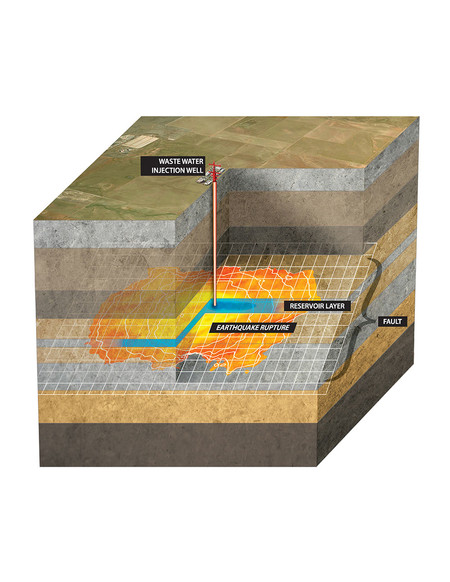搜索结果: 1-15 共查到“固体地球物理学 modeling”相关记录33条 . 查询时间(0.109 秒)

In work that offers insight into the magnitude of the hazards posed by earthquake faults in general, seismologists have developed a model to determine the size of an earthquake that could be triggered...
Analysis and quasistatic FE modeling of long period impulsive events associated with explosions at Stromboli volcano (Italy)
volcano seismology long-period measurements Stromboli finite element calculations volcano sources
2015/10/8
Broadband seismic measurements performed in 1995 and 1996 in the summit region of Stromboli are analyzed. The experiment in 1995 used an array of four Guralp seismometers and one Wielandt-Streckeisen ...
Tectonomagnetic modeling based on the piezomagnetism:a review
tectonomagnetic modeling piezomagnetism seismomagnetic effect of inclined fault enhancement effect of bore hole parkfield fault model
2015/9/28
Development of tectonomagnetic modeling on the basis of the piezomagnetic effect is reviewed for the period since the early 1990's. First, the basic theory is briefly summarized, in which the represen...
Earth modeling and estimation of the local seismic ground motion due to site geology in complex volcanoclastic areas
dynamic amplification factor seismic tomography pyroclastic rocks finite element method
2015/9/25
Volcanic areas often show complex behaviour as far as seismic waves propagation and seismic motion at surface are concerned. In fact, the finite lateral extent of surface layers such as lava flows, bl...
Geochemical modeling of magmatic gas scrubbing
magmatic gas magma degassing hydrothermalsystem crater lake meteoric water scrubbing reaction path modeling
2015/9/10
The EQ3/6 software package, version 7.2 was successfully used to model scrubbing of magmatic gas by pure
water at 0.1 MPa, in the liquid and liquid-plus-gas regions. Some post-calculations were neces...
Modeling the dynamic rupture propagation on heterogeneous faults with rate- and state-dependent friction
dynamic rupture fault constitutive law fault friction stress heterogeneities
2015/9/10
We investigate the effects of non-uniform distribution of constitutive parameters on the dynamic propagation of
an earthquake rupture. We use a 2D finite difference numerical method and we assume tha...
Numerical 2D modeling of site responsein Dinar Graben, Southwest Turkey,and comparison with observations
2D modeling basin edge effect Dinar site response
2015/9/10
The October 1, 1995 Dinar earthquake (ML=5.9) caused extensive damage within a limited area in Dinar town located
in southwestern Turkey. Graben structure of the damaged area suggests the basin edge ...
FEMSA: a finite element simulation tool for quasi-static seismic deformation modeling
faulting sources coseismic deformation finite element method PACS
2015/9/2
We set up a computational tool to numerically model static and quasi-static deformation generated by faulting
sources embedded in plane or spherical domains. We use a Finite Element (FE) approach to ...
Earthquake forecasting in Italy,before and after Umbria-Marche seismic sequence 1997.A review of the earthquake occurrence modeling at different spatio-temporal-magnitude scales
earthquake forecasting
2015/9/1
The main goal of this work is to review the scientific researches carried out before and after the Umbria-Marche sequence related to the earthquake forecasting/prediction in Italy. In particular, I fo...
Trade-off between seismic source detail and crustal heterogeneities in spherical 3D finite element modeling: a 2004 Sumatra earthquake case study
finite element method 3D modeling static deformation
2015/8/27
Finite-element methods are a powerful numerical simulation tool for modeling seismic events, as they allow three-dimensional complex models to be solved. We used a three-dimensional finite-element app...
Faulting mechanism of the Campania–Lucania 1980 earthquake, Italy, from high-resolution, 3D velocity structure, aftershock relocation, fault-plane solutions, and post-seismic deformation modeling
Campania-Lucania 1980 earthquake analyses of the post-seismic data
2015/8/27
This study performs a detailed reconstruction of the rupture mechanism of the 1980 Campania–Lucania (southern Italy) earthquake. This is achieved by relocation of the main event through computation of...
The role of radiation damping in the modeling of repeated earthquake events
Seismic cycle Earthquake recurrence Radiation damping Spring-slider model Fault rheology Computational seismology
2015/8/18
We have investigated the role of the radiation damping term (RDT) on repeated earthquake ruptures by modeling the faulting process through a single one-dimensional analog fault system governed by diff...
Earthquake and Tsunami Potential of the Hikurangi Subduction Thrust, New Zealand: Insights from Paleoseismology, GPS, and Tsunami Modeling
Hikurangi Subduction Thrust GPS
2015/7/17
The Hikurangi subduction margin, where the Pacific Plate subducts beneath the North Island of New Zealand, poses a major seismic and tsunami hazard to the New Zealand region, but its seismic and tsuna...
The Global Gridded Crop Model Intercomparison: data and modeling protocols for Phase 1 (v1.0)
Global Gridded Crop Model Intercomparison data
2015/3/5
We present protocols and input data for Phase 1 of
the Global Gridded Crop Model Intercomparison, a project
of the Agricultural Model Intercomparison and Improvement
Project (AgMIP). The project in...
Using the level set method in geodynamical modeling of multi-material flows and Earth's free surface
Tracking the material surface flow modeling multi - material flow modeling the level set function
2015/1/6
The level set method allows for tracking material surfaces in 2-D and 3-D flow modeling and is well suited for applications of multi-material flow modeling. The level set method utilizes smooth level ...


